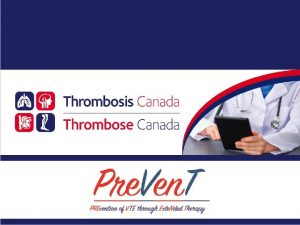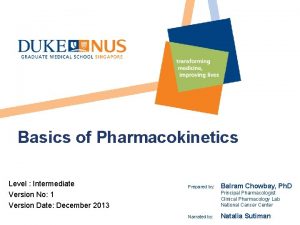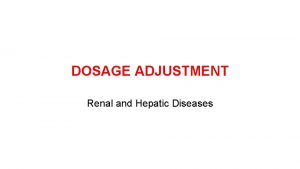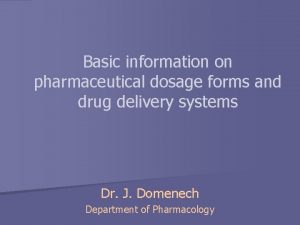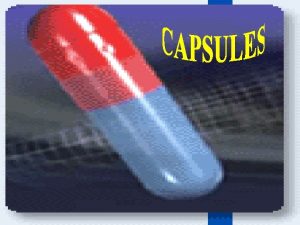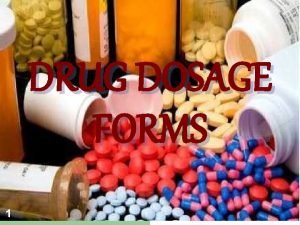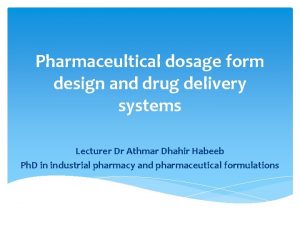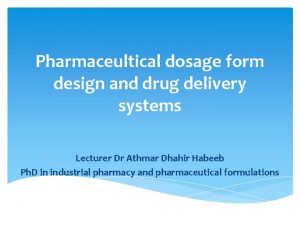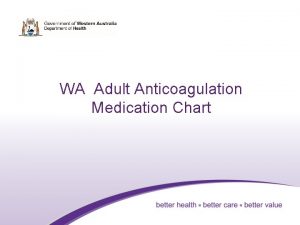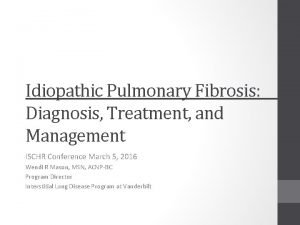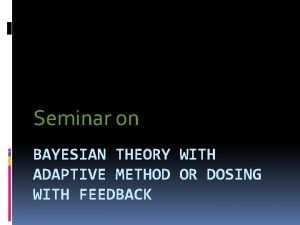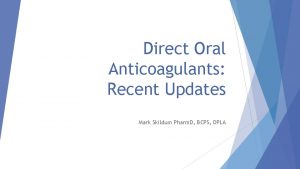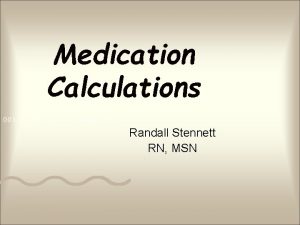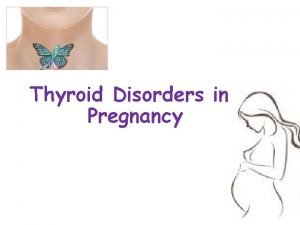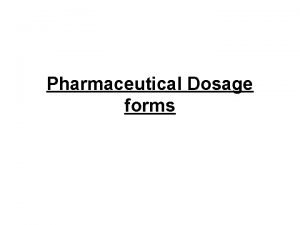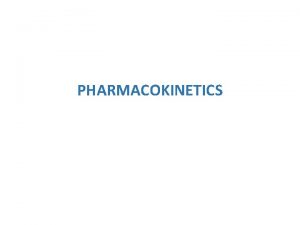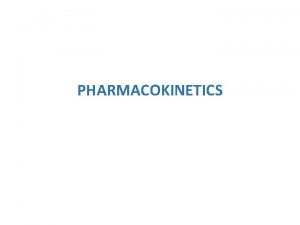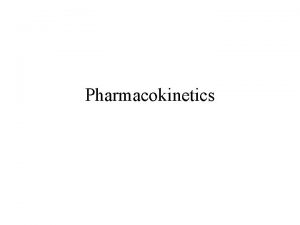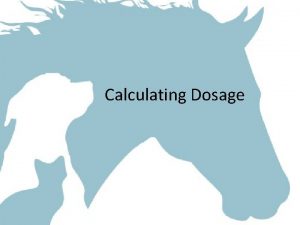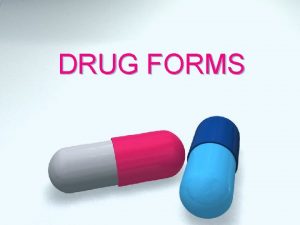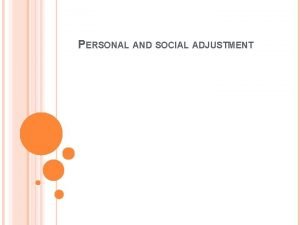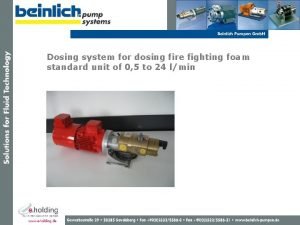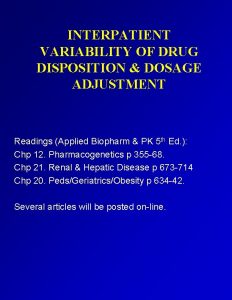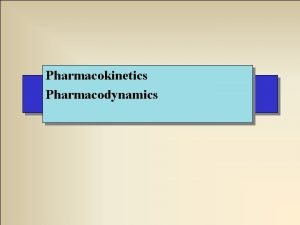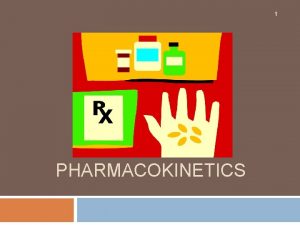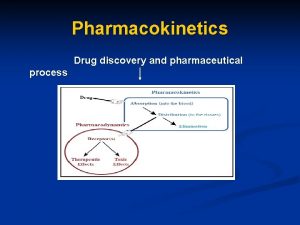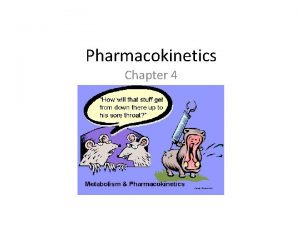Pharmacokinetics Drug Dosing Pharmacokinetics Dosage adjustment in renal





















- Slides: 21

Pharmacokinetics & Drug Dosing Pharmacokinetics Dosage adjustment in renal impairment Dialysis removal of drugs

Ideal drug for a renal patient Non-renal excretion No side effects Active drug No renally excreted metabolites

Pharmacokinetics of Renal Failure Bioavailability Distribution Metabolism Elimination Dialysis Modality

Bioavailability Definition : Amount of active drug in body Affected by: Altered gastro-intestinal motility Increased gastric p. H Uraemia Other medication e. g. phosphate binders

Distribution Altered by: Hydration – oedema & ascites Reduced protein binding - malnutrition Changes in tissue binding

Protein Binding Affected by: p. H Binding inhibitors Drugs or waste products Competing drugs Reduced plasma protein levels

Metabolism To convert drugs to more water soluble forms so they can be more easily excreted Reduced protein binding means more drug is available for metabolism Uraemic toxins can induce hepatic enzymes causing an increased metabolism of some drugs

Elimination Half Life Definition: Time taken for free drug concentrations to half Depends on: Glomerular filtration Active tubular excretion Passive tubular reabsorption

Drug Dosing Loading Dose Generally unchanged Maintenance Dose General rule - if a drug is normally excreted via the kidneys, its maintenance dose will need to be adjusted in patients with renal impairment.

Drug Dosing There are two ways of doing this: �Increase the dosing interval, dose remains unchanged �Decrease the dose, dosing interval remains unchanged �The objective is to produce a plasma drug profile which approaches that normally achieved in the absence of renal failure

Dose constant, Dosing Interval increased ------ Teicoplanin 400 mg every 72 hours _______ Teicoplanin 400 mg every 24 hours Log plasma concentration 0 1 2 Time (days) 3

Dose reduced, Dosing Interval unchanged ------Digoxin 62. 5 mcg Q 24 hrs ______ Digoxin 250 mcg Q 24 hrs Log plasma concentration 0 1 2 Time (days) 3

Where to look for Information BNF ? ? ? SPC Renal Drug Handbook Drug Prescribing in Renal Failure: Dosing Guidelines for Adults (Aronoff) Drug company (remember to prod them!) Clinical papers (usually case studies!) SPC’s from other countries Other colleagues

Take care with the following drugs Low therapeutic window Renally excreted e. g. aminoglycosides, digoxin Active metabolites which are renally excreted e. g. morphine Remember to increase doses of drugs as renal failure improves.

Drugs to take care with in renal Impairment Antibiotics especially penicillins and cephalosporins – lower dose is required, neurotoxic. Ciprofloxacin and macrolides cause nausea if the dose is too high. Lower doses with gentamicin and vancomycin Antivirals e. g. aciclovir need to drastically reduce dose otherwise very neurotoxic and will become nauseas

Biological actions which may be altered in renal failure Hypovolaemia: enhances antihypertensive effect: antihypertensives – start low dose but increase to maximum dose – Don’t believe the BNF! Uraemia: can cause excess bleeding Enhanced CNS sensitivity to centrally acting drugs e. g. analgesics especially opiates, antidepressants Electrolyte variations e. g. digoxin toxicity

Biological actions which may be altered in renal failure Hyperkalaemia: enhanced side effects with ACE-I, ARB’s, K+ sparing diuretics & potassium salts

Removal by intermittent dialysis Haemodialysis: Peritoneal Dialysis: Surface area, type & permeability of dialyser Blood flow rate Dialysate flow rate Duration of dialysis Drug: M Wt, Protein binding Concentration gradient between dialysate & plasma Peritoneum permeability Volume & frequency of exchanges Drug: Vd, Protein binding, renal excretion

Drugs most likely to be dialysed: �Low molecular weight (HD < 500 Da, HDF < 20, 000 Da) �Low protein binding �Small volume of distribution (< 1 Kg/L) �Water soluble �Renally cleared (>50%)

Removal by CRRT Vd < 0. 7 L/kg Molecular weight < 5000 Da Protein binding < 80% Route of excretion UF rate Type of dialyser Blood flow rate Sieving co-efficient (close to 1)

Comparison of RRT
 Res extra commercium
Res extra commercium Teoria do nefron intacto
Teoria do nefron intacto Lovenox renal dosing
Lovenox renal dosing Drug metabolism and pharmacokinetics
Drug metabolism and pharmacokinetics Cortical and juxtamedullary nephrons difference
Cortical and juxtamedullary nephrons difference Dpp-4 inhibitors side effects
Dpp-4 inhibitors side effects Loading dose formula in pharmacology
Loading dose formula in pharmacology Hepatic extraction ratio formula
Hepatic extraction ratio formula Chart of dosage form
Chart of dosage form Dosage forms and drug delivery systems
Dosage forms and drug delivery systems Classification of liquid dosage form
Classification of liquid dosage form Shelf life of drug
Shelf life of drug Dosage forms and drug delivery systems
Dosage forms and drug delivery systems Example of substitution with exhausted drug is
Example of substitution with exhausted drug is Wa anticoagulation chart
Wa anticoagulation chart Ischr
Ischr Adaptive method or dosing with feedback
Adaptive method or dosing with feedback Def dosing unit relay
Def dosing unit relay Cricothyrotomy pronunciation
Cricothyrotomy pronunciation Noac vs doac
Noac vs doac Medication formula
Medication formula Methimazole dosing guidelines
Methimazole dosing guidelines


